Pests
Aphelenchoides besseyi Christie - White Tip of Rice, Rice White Tip Nematode
Systematic position.
Phylum Nematoda, class Secernentea, order Aphelenchida, suborder Aphelenchina, superfamily Aphelenchoidea, family Aphelenchoididae, genus Aphelenchoides (http://www.faunaeur.org).Synonyms.
Aphelenchoides oryzae Yokoo.Biological group.
Obligate parasite.Morphology and biology.
Females, males, and larvae are vermiform; eggs are oval. Body length of female is 0.62-0.88 mm, a=38-58; body length of male is 0.44-0.72 mm, a=36-47. The male body has bent ventrad tail (by 180°). Nematodes of all instars keep under caryopsis husk. Therefore, they get to the fields with crop seeds, remaining also in fallen grain and ears. In spring at high humidity, they crawl on the plants and localize in leaf sheaths, where they feed by cell content. This nematode is an ectoparasite. As a result of the infestation, the rice leaf tips (to 5 cm) become white; so this disease is called the White Tip of Rice. Then the leaves get darker, coil up and die off. At the stage of flowering, the nematodes enter florets and localize under caryopsis husk. Their numbers sometimes reach one thousand or more. The nematodes can survive in caryopsis for up to 5 years. As a result of infestation, panicles become underdeveloped or completely seedless, and yield decreases. The nematode has up to 13 generations per season; female fecundity is 50 eggs per cycle.Distribution.
This nematode is distributed in all regions of rice growing in the world. In the Russian Federation, the zone of wide distribution and high severity is established since 1960s in Krasnodar, Stavropol, and Primorskii Territories, Astrakhan and Rostov Regions, Dagestan, Chechnya, Ingushetia, Kabardino-Balkaria.Ecology.
This species is thermophilic; the nematodes are unable to survive in anhydrobiosis. The lower threshold of development is 13°C, the optimum temperature varies between 23°C and 30°C. The sum of effective temperatures for the development of one generation is 80 degree-days.Economic significance.
The rice yield decrease is conditioned by the disease distribution in the field and by the extent of plant infestation. The greatest losses (75%) have been observed in Krasnodar Territory under disease distribution 50% and more. The A. besseyi severity is possible to reduce by sorting out the infested seed material, by seed dressing with nematocide Tecto, by growing tolerant rice cultivars (Kuban 3, Santakhezskii 3, Fu-to, Alakulskii), plowing-in stubble remains, and avoiding stream-born transmission.Reference citations:
Borovkova A.M. 1967. Aphelenchoides besseyi in the USSR and its control. In: Sveshnikova N.M., ed. Nematode diseases of agricultural plants. Moscow: Kolos. 153-157 p. (in Russian).Decker H. 1963. Pflanzenparasitare Nematoden und ihre Bekampfung. Berlin: VEB Deutscher Landwirtschaftsverlag. 374 p. (in German).
Kir'yanova E.S., Krall' E.L. 1971. Parasitic plant nematodes and their control measures. V.2. Leningrad: Nauka. 405 p. (in Russian).
Sudakova I.M., Glushenkov N.A. 1967. Attempt of prognosis of Aphelenchoides bessey Christie. 1942 severity in regions of rice growing in the USSR. In: Sveshnikova N.M., ed. Nematode diseases of agricultural plants. Moscow: Kolos. 135-138 p. (in Russian).
Sudakova I.M., Maslennikova B.F. 1968. Aphelenchoides bessey Christie - the pest of white tip of rice. In: Materials of conf. Soc. helminthology of Uzbekistan. Tashkent: 193-105. (in Russian).
Tikhonova L.V. 1967. Biological basis of Aphelenchoides bessey control. Bulletin VIGIS 1: 115-117. (in Russian).


